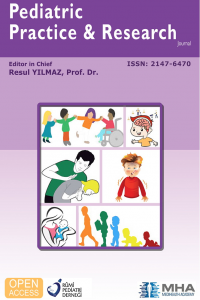Konjenital Ağrı Duyarsızlığı ile Anhidrosis Sendromu: Diyala vilayeti / Irak’tan Bir Olgu Sunumu
CIPA, kendini yaralama, kendini yaralama
Congenital insensitivity to pain with anhidrosis syndrome: A case report in Diyala province / Iraq
CIPA, self-mutilation, osteomyelitis,
___
- 1-Altassan R, Al SH, Masoodi TA, Al DH, Khalifa O, Al-Zaidan H, et al. Exome sequencing identifies novel NTRK1 mutations in patients with HSAN-IV phenotype. Am J Med Genet Part A. 2017;173:1009–16.
- 2-Pérez-López LM, Cabrera-González M, Gutiérrez-de la Iglesia D, Ricart S, Knörr-Giménez G. Update review and clinical presentation in congenital insensitivity to pain and anhidrosis. Case Rep Pediatr. 2015;2015:1–7.
- 3-Beigelman A, Levy J, Hadad N, Pinsk V, Haim A, Fruchtman Y, et al. Abnormal neutrophil chemotactic activity in children with congenital insensitivity to pain with anhidrosis (CIPA): the role of nerve growth factor. Clin Immunol. 2009;365–72.
- 4-Van Ness Dearborn G. A case of congenital general pure analgesia. J Nerv Ment Dis. 1932;75:612–5
- 5-Rasmussen P. The congenital insensitivity-to-pain syndrome (analgesia congenita) Int J Paediatr Dent. 1996;6:117–22.
- 6-Lrod FB, Hilz MJ. Inherited autonomic neuropathies. Semin Neurol. 2003;23(4):381–90.
- 7-Monique M. Ryan. Congenital Insensitivity to Pain and Anhidrosis. Nelson Textbook of Pediatrics21th ed., 2020;633.2: 12893.
- 8-Shorer Z, Moses SW, Hershkovitz E, et al. Neurophysiologic studies in congenital insensitivity to pain with anhidrosis. Pediatric neurology. 2001; 25: 397-400.
- 9-Daneshjou K, Jafarieh H, Raaeskarami SR. Congenital Insensitivity to Pain and Anhydrosis (CIPA) Syndrome; A Report of 4 Cases. Iranian journal of pediatrics. 2012; 22: 412-416.
- 10-Indo Y. Nerve growth factor, pain, itch, and inflammation: lessons from congenital insensitivity to pain with anhidrosis. Expert review of neurotherapeutics. 2010; 10: 1707-1724.
- 11-Zhang Y, Haga N. Skeletal complications in congenital insensitivity to pain with anhidrosis: a case series of 14 patients and review of articles published in Japanese. Journal of orthopedic science: official journal of the Japanese Orthopaedic Association. 2014; 19: 827-831.
- 12-asnur AH, Sasnur PA, Ghaus-Ul RS. Congenital insensitivity to pain and anhidrosis. Indian J Orthop. 2011 May-Jun;45(3):269–71.
- 13-Li N, Sun J, Guo S, Liu Y, Wang C, Zhu C, et al. Phenotypic and genotypic features of a pair of Chinese identical twins with congenital insensitivity to pain and anhidrosis: A case report. Medicine (Baltimore). 2018;97:e13209.
- 14-Hartono F, Tanjung C, Besinga KE, Marpaung D, Ananditya T, Budisantoso AB. Catastrophic results due to unrecognizing of congenital insensitivity to pain with anhidrosis in children with multiple long bones fractures: A case report of 27 years follow-up of two siblings. Int J Surg Case Rep. 2020;73:213-7.
- 15-Hutton A, McKaig S: The dental management of a child with congenital insensitivity to pain. Dent Update. 2010, 37:180-185. 10.12968/denu.2010.37.3.180
- 16. Schwarzkopf R, Pinsk V, Weisel Y, et al. : Clinical and genetic aspects of congenital insensitivity to pain with anhidrosis]. Harefuah. 2005; 144: 433-437, 453, 452.
- 17-Nabiyev V, Kara A, Aksoy MC. Multidisciplinary assessment of congenital insensitivity to pain syndrome. Child's nervous system: ChNS: official journal of the International Society for Pediatric Neurosurgery. 2016; 32: 1741-1744.
- 18-Abdulla M, Khaled SS, Khaled YS, et al. Congenital insensitivity to pain in a child attending a paediatric fracture clinic. Journal of pediatric orthopedics Part B. 2014; 23: 406-410.
- 19-Szoke G, Renyi-Vamos A, Bider MA. Osteoarticular manifestations of congenital insensitivity to pain with anhydrosis. International orthopaedics. 1996; 20: 107-110
- 20- Mughal S M, Farhat A (January 29, 2021) Case Study of a Rare Genetic Disorder: Congenital Insensitivity to Pain With Anhidrosis. Cureus 13(1): e12984.
- 21-Khadije Daneshjou, MD, Hanieh Jafarieh, MD,* and Seyed-Reza Raaeskarami, MDCongenital Insensitivity to Pain and Anhydrosis (CIPA) Syndrome; A Report of 4 Cases. Iran J Pediatr. 2012 Sep; 22(3): 412–416.
- 22-Mehran KARIMI, MD 1 and Razieh FA LLAH, MD, A Case Report of Congenital Insensitivity to Pain and Anhidrosis (CIPA) Iran J Child Neurol. 2012 Summer; 6(3): 45–48.
- 23- Fruchtman Y., Perry Z. H., Levy J. Morbidity characteristics of patients with congenital insensitivity to pain with anhidrosis (CIPA) Journal of Pediatric Endocrinology and Metabolism. 2013;26(3-4):325–332.
- 24- Priya Rajbansh, Mamta Yadav, Piyush Kumar, and Anupam Das, Congenital Insensitivity to Pain with Anhidrosis: A Rare Entity, Indian Dermatol Online J. 2020; 11(2): 274–277.
- 25- Miranda, C., Selleri, S., Pierotti, M., Greco, A. :The M581V Mutation, Associated with a Mild Form of Congenital Insensitivity to Pain with Anhidrosis, Causes Partial Inactivation of the NTRK1 Receptor. Journal of Investigative Dermatology.2002; 119(4), 978-979.
- 26. Gherlinzoni F, Gherlinzoni G, Neurogenic joint disease secondary to congenital insensitivity to pain. Italian Journal of Orthopaedics and Traumatology, 01 Dec 1982, 8(4):487-496
- 27. Al Amroh HH, Reyes AL, Barret Austin Hillary J, Al Khaffaf WH. Painless: a case of congenital insensitivity to pain in a 5-year-old male. Oxf Med Case Reports. 2020 24; (7):omaa046.
- ISSN: 2147-6470
- Başlangıç: 2013
- Yayıncı: MediHealth Academy Yayıncılık
Konjenital Ağrı Duyarsızlığı ile Anhidrosis Sendromu: Diyala vilayeti / Irak’tan Bir Olgu Sunumu
GÖZ BULGULARININ EŞLİK ETTİĞİ TRİZOMİ 13 VAKASI SUNUMU
Kazım DARKA, Arif İsmet ÇATAK, Erhan KARAASLAN
Parvovirus B19'a Bağlı Akut Pleuro-Perikardit: 17 Yaşındaki Bir Erkek Çocuğun Olgu Sunumu
Melih Timuçin DOĞAN, Elif ÇOBAN, Murat SÜTÇÜ
Acil Servise Demir Zehirlenmesi İle Başvuran Çocuk Vakalarının Değerlendirilmesi
Bahar ÜRÜN UNAL, Duygu İlke YILDIRIM, Sevil ŞEN, Alaaddin YORULMAZ
Çocukluk döneminde labial füzyona yaklaşımımız: Tek merkezde sekiz yıllık deneyim.
Çocuklarda Obezitenin Postoperatif Derlenme Ajitasyonuna Etkisi
Mehmet SARGIN, Emine ASLANLAR, Fatma SARGIN
Çocuklarda Nöbet ile Prezente Olan Nadir Görülen Nöraksisin Kalsifiye Psödoneoplazmı (CAPNON)
Kübra TAŞAR, Abdullah CANBAL, Burcu ÇALIŞKAN, Saliha YAVUZ ERAVCI, Cengiz KADIYORAN, Mehmet Fatih ERDİ, Ahmet GÜVEN
Nilgün HARPUTLUOĞLU, Duygu ÇUBUKÇU, Sibel DURAK, Tanju ÇELİK
